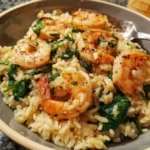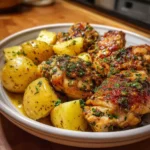Of all the dishes in my weekly rotation, there are few that disappear from the table as quickly as this Garlic Shrimp and Spinach Rice. The first time I made it, I was simply trying to use up a bag of spinach and some shrimp I had in the freezer, hoping for a decent, quick meal. I had no idea I was about to stumble upon my family’s new obsession. The aroma alone is enough to bring everyone to the kitchen—a fragrant cloud of sizzling garlic, savory broth, and a hint of zesty lemon. My kids, who are usually skeptical of anything green, devour the spinach without a second thought, perfectly wilted into the fluffy, flavorful rice. My husband, a man of few words when it comes to food, simply gave a thumbs-up and asked, “Is there more?” It’s that perfect balance of being incredibly easy to make in one pan, yet tasting like something you’d get at a favorite seaside restaurant. It’s become our go-to for busy weeknights, a reliable crowd-pleaser for casual get-togethers, and my personal secret weapon for turning a stressful day into a delicious evening. This isn’t just a recipe; it’s a solution—a flavorful, wholesome, and joy-inducing meal that never fails to impress.
Ingredients for The Ultimate Garlic Shrimp and Spinach Rice
This recipe relies on a handful of fresh, high-quality ingredients to create its signature flavor. Each component plays a crucial role, coming together to form a perfectly balanced and delicious one-pan meal.
- Extra Virgin Olive Oil (2 tablespoons): This forms the rich, flavorful base for sautéing our aromatics. Use a good quality extra virgin olive oil for a peppery, fruity note that complements the other ingredients.
- Large Shrimp (1.5 pounds): The star of the show. You’ll want large shrimp (about 21-25 count per pound), peeled and deveined. You can leave the tails on for a more elegant presentation or remove them for easier eating.
- Garlic (8 cloves): Don’t be shy with the garlic! Eight cloves, finely minced, are essential for that robust, aromatic flavor that defines the dish. Freshly minced garlic is non-negotiable for the best taste.
- Yellow Onion (1 medium): Finely chopped, the onion provides a sweet, savory foundation that deepens the overall flavor profile of the rice.
- Long-Grain White Rice (1 ½ cups): Uncooked long-grain white rice, such as Jasmine or Basmati, works best as it cooks up fluffy and absorbs the flavors of the broth beautifully without becoming mushy.
- Low-Sodium Chicken or Vegetable Broth (3 cups): This is our cooking liquid. Using a low-sodium broth allows you to control the saltiness of the final dish. Chicken broth adds a richer flavor, while vegetable broth is a great alternative.
- Low-Sodium Soy Sauce (1 tablespoon): Adds a touch of umami and depth of color. Tamari can be used as a gluten-free substitute.
- Red Pepper Flakes (½ teaspoon): This provides a gentle, warming heat that cuts through the richness of the dish. Adjust the amount based on your personal preference for spice.
- Fresh Spinach (5 ounces): A large bag of fresh baby spinach will wilt down perfectly, adding vibrant color, nutrients, and a subtle earthy flavor that pairs wonderfully with the garlic and lemon.
- Lemon (1 whole): We’ll use both the zest and the juice. The zest adds a fragrant citrus oil aroma, while the fresh juice, added at the end, brightens up all the flavors and gives the dish a clean, fresh finish.
- Fresh Parsley (¼ cup): Chopped fresh parsley, stirred in at the end and used as a garnish, adds a final burst of freshness and color.
- Salt and Black Pepper (to taste): For seasoning the shrimp and adjusting the final dish to your liking.
Step-by-Step Instructions for Perfect Results
Follow these detailed steps carefully to ensure your Garlic Shrimp and Spinach Rice comes out perfectly every single time. The key is to build layers of flavor in the pan.
Phase 1: Preparing and Searing the Shrimp
- Pat the Shrimp Dry: Begin by thoroughly patting the peeled and deveined shrimp dry with paper towels. This step is crucial for getting a beautiful, golden-brown sear rather than just steaming the shrimp.
- Season Generously: Place the dried shrimp in a medium bowl. Drizzle with about 1 tablespoon of olive oil and season generously with salt and black pepper. Toss to ensure every shrimp is evenly coated.
- Sear the Shrimp: Heat the remaining 1 tablespoon of olive oil in a large, deep skillet or Dutch oven over medium-high heat. Once the oil is shimmering, add the shrimp in a single layer. Be careful not to overcrowd the pan; work in two batches if necessary. Cook for 1-2 minutes per side, just until they turn pink and opaque and develop a slight golden crust. They do not need to be cooked all the way through at this point, as they will finish cooking later.
- Set Aside: Using a slotted spoon, remove the seared shrimp from the skillet and set them aside on a plate.
Phase 2: Building the Flavor Base
- Sauté the Aromatics: Reduce the heat to medium. Add the chopped yellow onion to the same skillet, scraping up any delicious browned bits left behind by the shrimp. Cook for 3-4 minutes, stirring occasionally, until the onion has softened and become translucent.
- Bloom the Garlic and Spices: Add the minced garlic and red pepper flakes to the skillet. Sauté for about 60 seconds, stirring constantly, until the garlic is incredibly fragrant. Be very careful not to let the garlic burn, as it will become bitter and ruin the dish.
- Toast the Rice: Add the uncooked rice directly into the skillet with the aromatics. Stir continuously for 1-2 minutes. This toasting step coats each grain of rice in the flavorful oil and gives the finished dish a nuttier flavor and a better, less sticky texture.
Phase 3: Cooking the Rice and Bringing It All Together
- Deglaze and Add Liquids: Pour in the chicken or vegetable broth and the soy sauce. Use a wooden spoon or spatula to scrape the bottom of the pan, releasing any remaining browned bits of flavor. This process, called deglazing, is essential for a deep-tasting dish.
- Simmer: Bring the liquid to a boil. Once boiling, reduce the heat to low, cover the skillet tightly with a lid, and let it simmer for 15-18 minutes, or until the rice has absorbed most of the liquid. Avoid lifting the lid during this time, as it will release the steam needed to cook the rice properly.
- Wilt the Spinach: Remove the lid. The rice should be tender. Scatter the fresh spinach and the lemon zest over the top of the rice. Place the lid back on the skillet for 2-3 minutes to allow the residual heat and steam to wilt the spinach.
- Combine and Finish: Remove the lid and gently fluff the rice with a fork, incorporating the wilted spinach. Return the seared shrimp and any accumulated juices from the plate back into the skillet.
- Final Touches: Squeeze the juice of half the lemon over the entire dish and stir in the chopped fresh parsley. Gently stir everything together to combine and allow the shrimp to heat through for another minute. Taste and adjust seasoning with more salt, pepper, or lemon juice if needed.
A Glimpse into the Nutrition Facts
While this dish feels indulgent, it’s packed with beneficial nutrients. The following information is an approximation and can vary based on specific ingredients used.
- Servings: 4-6 servings
- Calories Per Serving: Approximately 450-550 kcal
- Rich in Lean Protein: A single serving provides a substantial amount of high-quality, lean protein from the shrimp. Protein is crucial for muscle repair, immune function, and keeping you feeling full and satisfied.
- Excellent Source of Vitamin K: The generous amount of fresh spinach makes this dish a powerhouse of Vitamin K, which is vital for blood clotting and promoting strong, healthy bones.
- High in Iron: Spinach also contributes a significant amount of iron, an essential mineral that helps transport oxygen throughout your body, preventing fatigue and boosting energy levels.
- Packed with Vitamin C: The fresh lemon juice and parsley provide a powerful dose of Vitamin C, a potent antioxidant that supports the immune system and enhances iron absorption from the spinach.
- Source of Selenium: Shrimp is one of the best dietary sources of selenium, an important antioxidant mineral that helps protect cells from damage and plays a key role in thyroid health.
Quick and Efficient: Preparation Time Breakdown
This one-pan wonder is designed for efficiency, making it an ideal choice for any night of the week.
- Preparation Time: 15 minutes
This includes time for peeling and deveining the shrimp (if not already done), chopping the onion, mincing the garlic, zesting and juicing the lemon, and measuring out all the other ingredients. - Cooking Time: 25-30 minutes
This covers the entire cooking process from searing the shrimp to the final simmer of the rice. Because everything happens in one skillet, cleanup is just as fast as the cooking.
How to Serve Your Garlic Shrimp and Spinach Rice Masterpiece
The beauty of this dish is its versatility. It can be served simply as is or dressed up for a more special occasion. Here are some wonderful ways to present and enjoy it:
- As a Standalone Meal:
- Spoon generous portions directly into wide, shallow bowls. The all-in-one nature of the protein, grain, and vegetable means it doesn’t need anything else to be a complete, satisfying meal.
- Elevated with Garnishes:
- Fresh Lemon Wedges: Always serve with extra lemon wedges on the side. A final squeeze of fresh juice right before eating elevates all the flavors.
- More Fresh Herbs: A final sprinkle of chopped parsley or even some fresh chives adds a pop of color and fresh flavor.
- A Touch of Spice: Offer extra red pepper flakes or a drizzle of chili oil for those who enjoy more heat.
- Parmesan Cheese: A light shaving of high-quality Parmesan cheese can add a salty, nutty complexity that works surprisingly well.
- Paired with Simple Sides:
- Crusty Bread: Serve with warm, crusty bread like a baguette or ciabatta. It’s perfect for soaking up any leftover savory juices at the bottom of the bowl.
- A Simple Green Salad: A light salad with a simple vinaigrette offers a crisp, refreshing contrast to the warm, savory rice dish.
- For a Gathering:
- Serve it family-style directly from the skillet or a large platter placed in the center of the table. It creates a warm, communal, and rustic atmosphere.
- Wine Pairing Suggestions:
- Sauvignon Blanc: A crisp, dry Sauvignon Blanc with citrus and herbal notes is a classic pairing for garlic shrimp, cutting through the richness and complementing the lemon.
- Pinot Grigio: Another excellent choice, a light and zesty Pinot Grigio will refresh the palate without overpowering the delicate flavors of the dish.
Additional Tips for Culinary Success
Take your Garlic Shrimp and Spinach Rice from great to absolutely unforgettable with these eight professional tips.
- The Golden Rule: Don’t Overcook the Shrimp: This is the most important tip. Shrimp cook in mere minutes. The initial sear is just to develop flavor and color. They will finish cooking in the residual heat of the rice. Overcooked shrimp become tough and rubbery. When they curl into a “C” shape, they are cooked; if they curl into a tight “O,” they are overcooked.
- Properly Thaw Frozen Shrimp: If using frozen shrimp, thaw them correctly for the best texture. The ideal method is to place them in a colander in the refrigerator overnight. For a quicker method, place them in a colander and run cold (never warm) water over them until thawed, which should take about 10-15 minutes.
- Fresh is Best for Spinach: While you can use frozen spinach in a pinch, fresh baby spinach is highly recommended. It has a much better texture and a milder flavor. Frozen spinach releases a lot of water, which can make the final dish soggy if you’re not careful to squeeze it out completely.
- Unlock Flavor by Toasting the Rice: Don’t skip the step of toasting the rice in the pan with the aromatics. This simple technique coats each grain in the flavorful oil, giving the finished rice a slightly nutty aroma and helping the grains remain separate and fluffy.
- Master the Art of Deglazing: When you add the broth to the hot pan, use your spoon to actively scrape the bottom. Those browned bits (called “fond”) are concentrated pockets of flavor from the shrimp and aromatics. Releasing them into the broth is the secret to a restaurant-quality, deeply savory sauce.
- Control the Spice: The half teaspoon of red pepper flakes provides a mild, background warmth. If your family is sensitive to spice, start with just a quarter teaspoon. If you love heat, feel free to increase it to a full teaspoon or even add a finely diced jalapeño along with the onion.
- The Power of Fresh Lemon: Use a fresh lemon for both the zest and the juice. Bottled lemon juice lacks the bright, aromatic oils found in a fresh lemon and can have a muted, slightly bitter taste. The zest adds fragrance without extra acidity, while the juice, added at the very end, brightens and ties all the flavors together.
- For a Creamier Texture: If you prefer a creamier rice dish, you can stir in 2-3 tablespoons of heavy cream, half-and-half, or even softened cream cheese at the very end when you add the shrimp back in. Stir until it’s fully incorporated for a richer, more luxurious finish.
Frequently Asked Questions (FAQ)
Here are answers to some of the most common questions about making this Garlic Shrimp and Spinach Rice recipe.
1. Can I use frozen, cooked shrimp instead of raw?
Yes, you can, but the method needs to be adjusted. Since the shrimp are already cooked, you don’t need to sear them. Skip the initial searing step. Prepare the rice and spinach as directed. Add the thawed, cooked shrimp into the skillet during the very last minute of cooking, just long enough to heat them through. This prevents them from becoming tough and overcooked.
2. How do I store and reheat leftovers?
Store any leftovers in an airtight container in the refrigerator for up to 3 days. To reheat, you can microwave it in 30-second intervals, stirring in between, until hot. For the best results, reheat it in a skillet over medium-low heat with a splash of water or broth to rehydrate the rice and prevent it from drying out.
3. Is this recipe gluten-free?
It can easily be made gluten-free. The main ingredient to watch is the soy sauce. Simply substitute the soy sauce with an equal amount of tamari or a certified gluten-free coconut aminos. Also, ensure your chicken or vegetable broth is certified gluten-free, as some brands contain gluten additives.
4. Can I make this with a different protein, like chicken?
Absolutely! This recipe is very adaptable. For chicken, use about 1 pound of boneless, skinless chicken breast or thighs, cut into bite-sized pieces. Season and sear the chicken pieces just as you would the shrimp, until golden brown and cooked through. Set aside and add them back at the end.
5. Can I use brown rice instead of white rice?
Yes, but you will need to adjust the cooking time and liquid amount. Brown rice takes significantly longer to cook (around 40-45 minutes) and typically requires more liquid. Increase the broth to about 3 ½ cups and be prepared for a longer simmer time. Follow the package directions for your specific type of brown rice for the best liquid-to-rice ratio.
6. My rice came out mushy or hard. What went wrong?
- Mushy Rice: This usually happens from too much liquid or from stirring the rice during the simmering phase. Stirring releases starches, leading to a gummy texture. Ensure you use the correct liquid ratio and resist the urge to peek or stir while it’s covered and simmering.
- Hard Rice: This is typically caused by not enough liquid, simmering at too high a temperature (causing the liquid to evaporate too quickly), or having a lid that doesn’t fit tightly, which allows steam to escape. Make sure the heat is on a true low simmer and the lid is secure.
7. Can I add other vegetables to this dish?
Yes, this is a great recipe for cleaning out the vegetable drawer! Finely chopped broccoli florets, sliced mushrooms, diced bell peppers, or peas would all be excellent additions. Add heartier vegetables like broccoli and bell peppers along with the onions to give them enough time to soften. Add quicker-cooking vegetables like peas along with the spinach.
8. Is this recipe kid-friendly?
It is generally very kid-friendly, but you can make a few adjustments to ensure it’s a hit. Consider reducing or omitting the red pepper flakes to eliminate the spice. You could also remove the tails from the shrimp before cooking to make them easier for little hands to eat. The combination of rice and shrimp is often popular with children, and the spinach is so well-integrated that even picky eaters might not mind it.

Garlic Shrimp and Spinach Rice
Ingredients
This recipe relies on a handful of fresh, high-quality ingredients to create its signature flavor. Each component plays a crucial role, coming together to form a perfectly balanced and delicious one-pan meal.
- Extra Virgin Olive Oil (2 tablespoons): This forms the rich, flavorful base for sautéing our aromatics. Use a good quality extra virgin olive oil for a peppery, fruity note that complements the other ingredients.
- Large Shrimp (1.5 pounds): The star of the show. You’ll want large shrimp (about 21-25 count per pound), peeled and deveined. You can leave the tails on for a more elegant presentation or remove them for easier eating.
- Garlic (8 cloves): Don’t be shy with the garlic! Eight cloves, finely minced, are essential for that robust, aromatic flavor that defines the dish. Freshly minced garlic is non-negotiable for the best taste.
- Yellow Onion (1 medium): Finely chopped, the onion provides a sweet, savory foundation that deepens the overall flavor profile of the rice.
- Long-Grain White Rice (1 ½ cups): Uncooked long-grain white rice, such as Jasmine or Basmati, works best as it cooks up fluffy and absorbs the flavors of the broth beautifully without becoming mushy.
- Low-Sodium Chicken or Vegetable Broth (3 cups): This is our cooking liquid. Using a low-sodium broth allows you to control the saltiness of the final dish. Chicken broth adds a richer flavor, while vegetable broth is a great alternative.
- Low-Sodium Soy Sauce (1 tablespoon): Adds a touch of umami and depth of color. Tamari can be used as a gluten-free substitute.
- Red Pepper Flakes (½ teaspoon): This provides a gentle, warming heat that cuts through the richness of the dish. Adjust the amount based on your personal preference for spice.
- Fresh Spinach (5 ounces): A large bag of fresh baby spinach will wilt down perfectly, adding vibrant color, nutrients, and a subtle earthy flavor that pairs wonderfully with the garlic and lemon.
- Lemon (1 whole): We’ll use both the zest and the juice. The zest adds a fragrant citrus oil aroma, while the fresh juice, added at the end, brightens up all the flavors and gives the dish a clean, fresh finish.
- Fresh Parsley (¼ cup): Chopped fresh parsley, stirred in at the end and used as a garnish, adds a final burst of freshness and color.
- Salt and Black Pepper (to taste): For seasoning the shrimp and adjusting the final dish to your liking.
Instructions
Follow these detailed steps carefully to ensure your Garlic Shrimp and Spinach Rice comes out perfectly every single time. The key is to build layers of flavor in the pan.
Phase 1: Preparing and Searing the Shrimp
- Pat the Shrimp Dry: Begin by thoroughly patting the peeled and deveined shrimp dry with paper towels. This step is crucial for getting a beautiful, golden-brown sear rather than just steaming the shrimp.
- Season Generously: Place the dried shrimp in a medium bowl. Drizzle with about 1 tablespoon of olive oil and season generously with salt and black pepper. Toss to ensure every shrimp is evenly coated.
- Sear the Shrimp: Heat the remaining 1 tablespoon of olive oil in a large, deep skillet or Dutch oven over medium-high heat. Once the oil is shimmering, add the shrimp in a single layer. Be careful not to overcrowd the pan; work in two batches if necessary. Cook for 1-2 minutes per side, just until they turn pink and opaque and develop a slight golden crust. They do not need to be cooked all the way through at this point, as they will finish cooking later.
- Set Aside: Using a slotted spoon, remove the seared shrimp from the skillet and set them aside on a plate.
Phase 2: Building the Flavor Base
- Sauté the Aromatics: Reduce the heat to medium. Add the chopped yellow onion to the same skillet, scraping up any delicious browned bits left behind by the shrimp. Cook for 3-4 minutes, stirring occasionally, until the onion has softened and become translucent.
- Bloom the Garlic and Spices: Add the minced garlic and red pepper flakes to the skillet. Sauté for about 60 seconds, stirring constantly, until the garlic is incredibly fragrant. Be very careful not to let the garlic burn, as it will become bitter and ruin the dish.
- Toast the Rice: Add the uncooked rice directly into the skillet with the aromatics. Stir continuously for 1-2 minutes. This toasting step coats each grain of rice in the flavorful oil and gives the finished dish a nuttier flavor and a better, less sticky texture.
Phase 3: Cooking the Rice and Bringing It All Together
- Deglaze and Add Liquids: Pour in the chicken or vegetable broth and the soy sauce. Use a wooden spoon or spatula to scrape the bottom of the pan, releasing any remaining browned bits of flavor. This process, called deglazing, is essential for a deep-tasting dish.
- Simmer: Bring the liquid to a boil. Once boiling, reduce the heat to low, cover the skillet tightly with a lid, and let it simmer for 15-18 minutes, or until the rice has absorbed most of the liquid. Avoid lifting the lid during this time, as it will release the steam needed to cook the rice properly.
- Wilt the Spinach: Remove the lid. The rice should be tender. Scatter the fresh spinach and the lemon zest over the top of the rice. Place the lid back on the skillet for 2-3 minutes to allow the residual heat and steam to wilt the spinach.
- Combine and Finish: Remove the lid and gently fluff the rice with a fork, incorporating the wilted spinach. Return the seared shrimp and any accumulated juices from the plate back into the skillet.
- Final Touches: Squeeze the juice of half the lemon over the entire dish and stir in the chopped fresh parsley. Gently stir everything together to combine and allow the shrimp to heat through for another minute. Taste and adjust seasoning with more salt, pepper, or lemon juice if needed.
Nutrition
- Serving Size: one normal portion
- Calories: 550





